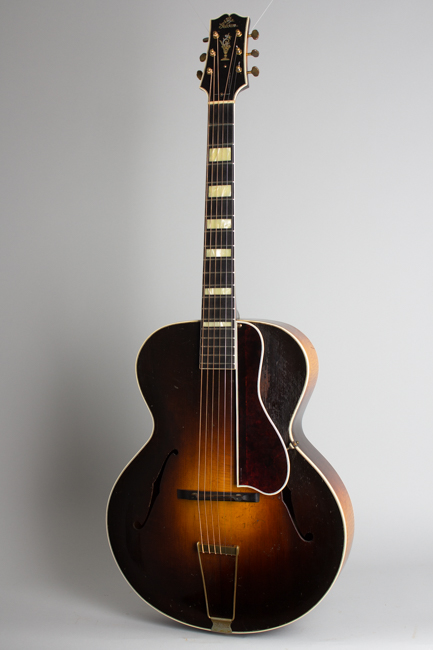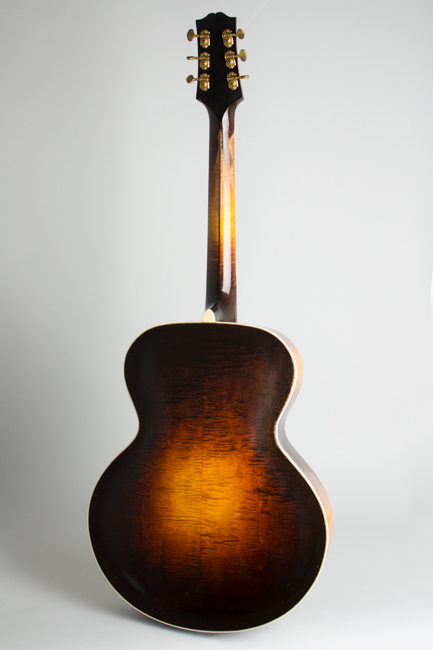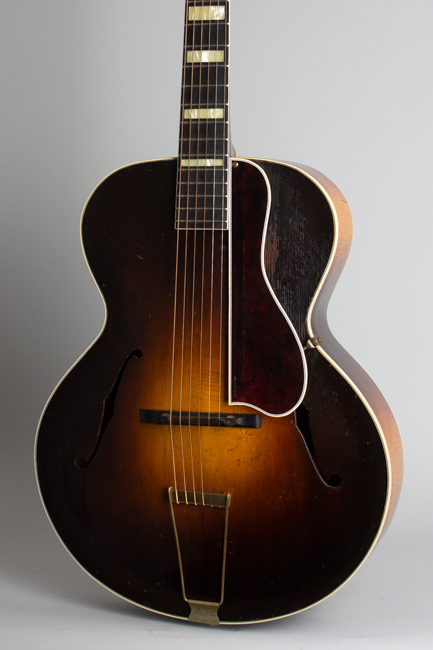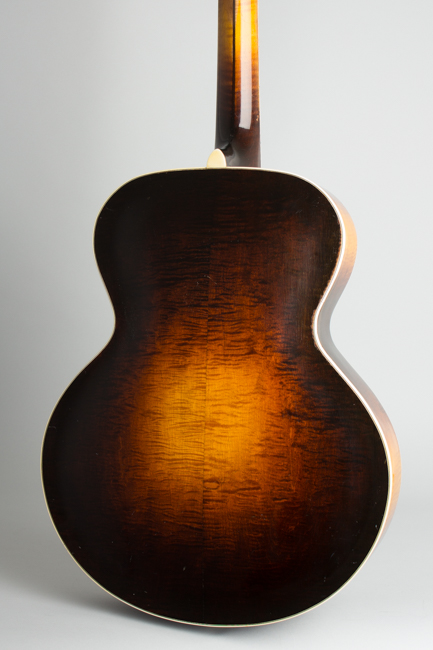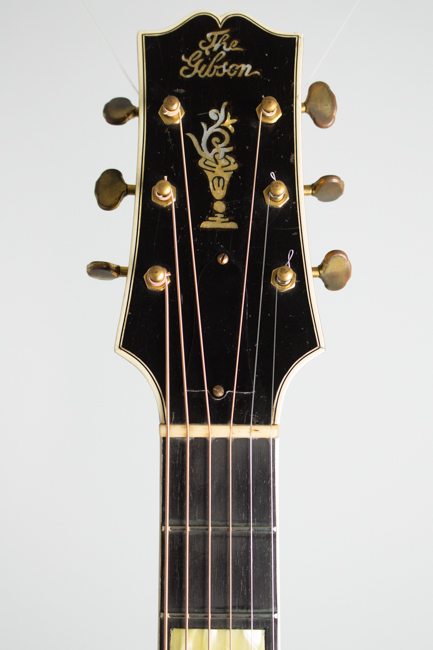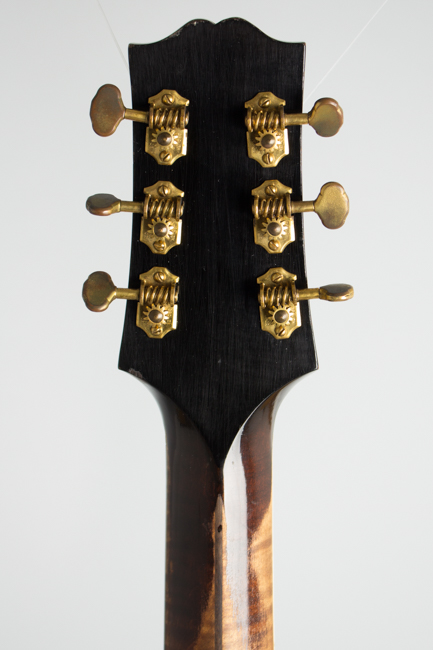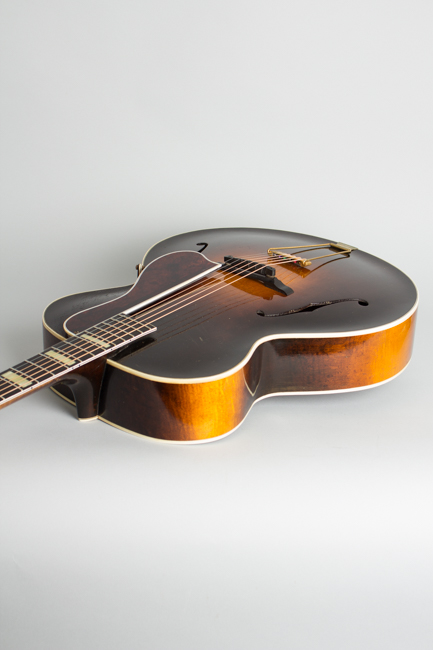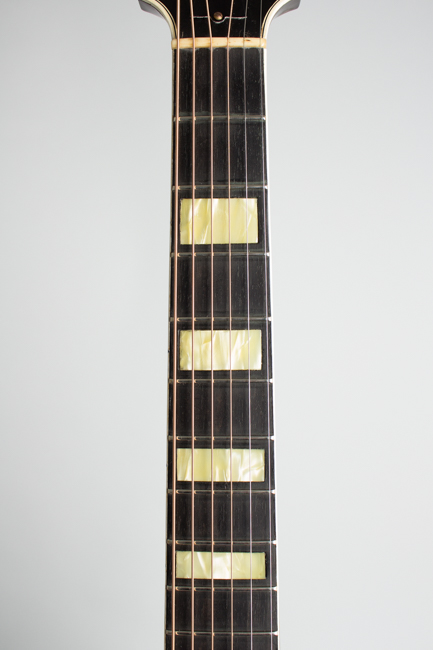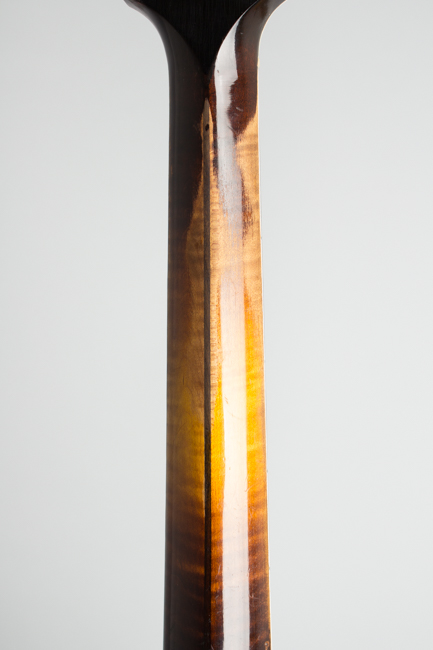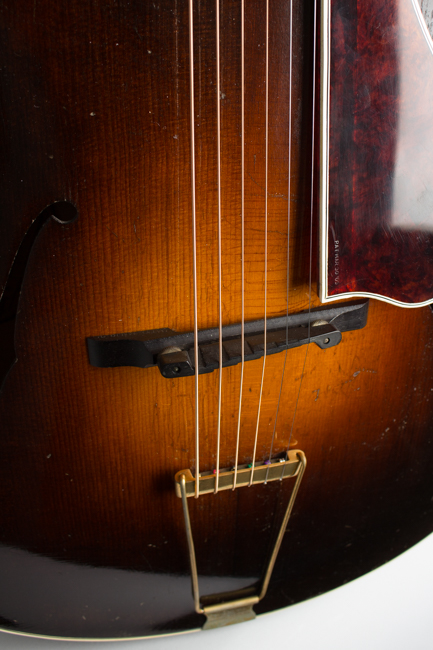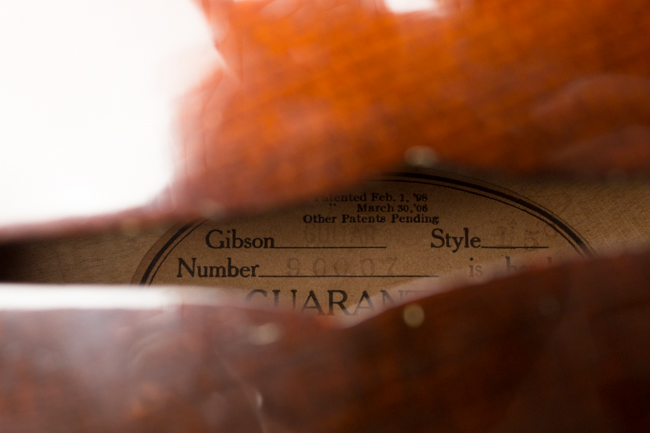Gibson L-5 Arch Top Acoustic Guitar (1933)
This item has been sold.
Item # 8420
Prices subject to change without notice.
Gibson L-5 Model Arch Top Acoustic Guitar (1933), made in Kalamazoo, Michigan, serial # 90007, Cremona Brown Sunburst finish, curly maple back and sides, spruce top; maple neck with ebony fingerboard, original black hard shell case.
This 1933 L-5 is a beautiful example of the pre-eminent orchestra guitar of its era -- the original f-hole archtop guitar -- and an extremely fine-sounding instrument. Debuting in 1923-4, the L-5 was the first modern archtop; at the time this one was built, nearly ten years later it was still the top of Gibson's line and generally considered the finest carved top guitar made.
Orchestra and jazz band banjoists had by this time almost universally converted to guitar; the $275.00 L-5 along with Epiphone's competing Deluxe were the choice of nearly all top professional guitar players of the time. Eddie Lang, the era's most influential guitarist, went from a Gibson L-4 to a dot-neck (probably 1927) L-5, then to an early block neck L-5 around 1930, setting the trend for all to follow. In 1933 the L-5 still ruled the roost for orchestra guitars, and gave Gibson a dominance in this style of instrument that the company never lost.
That said, these early L-5s are fairly rare guitars today. Retailing at $275.00 (plus case!), the L-5 was extremely expensive (a top-of-the-line Martin pearl-trimmed Style 0M-45 retailed exactly $100.00 less). At the height of the Depression, only top professional users with steady salaries could afford the indulgence of such an instrument.
Most 16" 1930s L-5s were used extensively for many years, some owners preferring them to any later guitars. They are still often seen in the hands of recording studio players well into the 1960s. As working guitars, these instruments have often been heavily modified, refitted, or refinished; like many, this one has had some minor restoration but remains a superb instrument with all of its original character.
This guitar shows typical features for an early 1930s L-5; the transition between variants of this model is particularly inexact. The side-line bound, straight-end ebony fingerboard has pearloid block inlay in place of the dots used on the earlier versions. The 3-piece laminated curly maple neck has a noticeable "V" spine with a relatively shallow profile. The pearl inlaid flowerpot in the triple-bound headstock and straight across "The Gibson" logo are the hallmarks of the 1930-33 L-5, as are the then-new Grover G-98 tuners with riveted gears and metal "butterbean" buttons.
The body on this particular guitar is slightly larger than many early L-5s at 16 3/16 inches wide, and is triple-bound back and front. The long triple-bound celluloid pickguard is screwed to the top by the neck block instead of pinned to the side of the fingerboard. The top, back, and sides carry a beautifully blended dark sunburst finish; the back is superb tight-grained curly maple. The tailpiece is the earlier "string over" style and the adjustable ebony bridge still has the 1920s "turnover" saddle for Hawaiian playing!
This particular guitar is extremely well-preserved; one of the finest from this era we have ever had. It has a powerful and very versatile sound typical of the best early L-5s; simultaneously warm and incisive with plenty of depth. It plays very well and is extremely responsive for an archtop guitar...it even sounds lovely fingerstyle! A wonderful example of one of our all-time favorite instruments.
Overall length is 40 3/4 in. (103.5 cm.), 16 3/16 in. (41.1 cm.) wide at lower bout, and 3 3/8 in. (8.6 cm.) in depth, measured at side of rim. Scale length is 24 3/4 in. (629 mm.). Width of nut is 1 3/4 in. (44 mm.).
This L-5 has been played seriously in the past but never abused. There is some typical restoration, but everything is to period specification. The finish is all original and unaltered except for some minor touch-up near the pickguard where the original piece suffered celluloid deterioration long ago. The newer repro celluloid pickguard is a beautifully executed replica, correct even down to the patent stamp and original-style celluloid mounting block. There is an additional small filled hole in the rim where another bracket was once mounted.
The original pearloid-block inlaid fingerboard has been trued, refretted, and meticulously rebound in the original style. The ebony bridge top piece is also an exact reproduction of the original, which is still present and stored in the original case, but has been cut down somewhat. Apart from these points, the guitar remains original and well-cared-for, but with some typical play wear. The back of the neck is partially worn down to the wood on the spine and in the lower positions. The finish overall shows checking and small dings and dents, but the only other really notable wear is on the top below the pickguard. There are no cracks or other repairs, not even the seam separations often seen.
This is a very fine-playing and sounding guitar; a superb example of this wonderful and historically important instrument. It is complete in its original case, which is fairly clean overall with some black tape added to the edges. Excellent - Condition.
This 1933 L-5 is a beautiful example of the pre-eminent orchestra guitar of its era -- the original f-hole archtop guitar -- and an extremely fine-sounding instrument. Debuting in 1923-4, the L-5 was the first modern archtop; at the time this one was built, nearly ten years later it was still the top of Gibson's line and generally considered the finest carved top guitar made.
Orchestra and jazz band banjoists had by this time almost universally converted to guitar; the $275.00 L-5 along with Epiphone's competing Deluxe were the choice of nearly all top professional guitar players of the time. Eddie Lang, the era's most influential guitarist, went from a Gibson L-4 to a dot-neck (probably 1927) L-5, then to an early block neck L-5 around 1930, setting the trend for all to follow. In 1933 the L-5 still ruled the roost for orchestra guitars, and gave Gibson a dominance in this style of instrument that the company never lost.
That said, these early L-5s are fairly rare guitars today. Retailing at $275.00 (plus case!), the L-5 was extremely expensive (a top-of-the-line Martin pearl-trimmed Style 0M-45 retailed exactly $100.00 less). At the height of the Depression, only top professional users with steady salaries could afford the indulgence of such an instrument.
Most 16" 1930s L-5s were used extensively for many years, some owners preferring them to any later guitars. They are still often seen in the hands of recording studio players well into the 1960s. As working guitars, these instruments have often been heavily modified, refitted, or refinished; like many, this one has had some minor restoration but remains a superb instrument with all of its original character.
This guitar shows typical features for an early 1930s L-5; the transition between variants of this model is particularly inexact. The side-line bound, straight-end ebony fingerboard has pearloid block inlay in place of the dots used on the earlier versions. The 3-piece laminated curly maple neck has a noticeable "V" spine with a relatively shallow profile. The pearl inlaid flowerpot in the triple-bound headstock and straight across "The Gibson" logo are the hallmarks of the 1930-33 L-5, as are the then-new Grover G-98 tuners with riveted gears and metal "butterbean" buttons.
The body on this particular guitar is slightly larger than many early L-5s at 16 3/16 inches wide, and is triple-bound back and front. The long triple-bound celluloid pickguard is screwed to the top by the neck block instead of pinned to the side of the fingerboard. The top, back, and sides carry a beautifully blended dark sunburst finish; the back is superb tight-grained curly maple. The tailpiece is the earlier "string over" style and the adjustable ebony bridge still has the 1920s "turnover" saddle for Hawaiian playing!
This particular guitar is extremely well-preserved; one of the finest from this era we have ever had. It has a powerful and very versatile sound typical of the best early L-5s; simultaneously warm and incisive with plenty of depth. It plays very well and is extremely responsive for an archtop guitar...it even sounds lovely fingerstyle! A wonderful example of one of our all-time favorite instruments.
Overall length is 40 3/4 in. (103.5 cm.), 16 3/16 in. (41.1 cm.) wide at lower bout, and 3 3/8 in. (8.6 cm.) in depth, measured at side of rim. Scale length is 24 3/4 in. (629 mm.). Width of nut is 1 3/4 in. (44 mm.).
This L-5 has been played seriously in the past but never abused. There is some typical restoration, but everything is to period specification. The finish is all original and unaltered except for some minor touch-up near the pickguard where the original piece suffered celluloid deterioration long ago. The newer repro celluloid pickguard is a beautifully executed replica, correct even down to the patent stamp and original-style celluloid mounting block. There is an additional small filled hole in the rim where another bracket was once mounted.
The original pearloid-block inlaid fingerboard has been trued, refretted, and meticulously rebound in the original style. The ebony bridge top piece is also an exact reproduction of the original, which is still present and stored in the original case, but has been cut down somewhat. Apart from these points, the guitar remains original and well-cared-for, but with some typical play wear. The back of the neck is partially worn down to the wood on the spine and in the lower positions. The finish overall shows checking and small dings and dents, but the only other really notable wear is on the top below the pickguard. There are no cracks or other repairs, not even the seam separations often seen.
This is a very fine-playing and sounding guitar; a superb example of this wonderful and historically important instrument. It is complete in its original case, which is fairly clean overall with some black tape added to the edges. Excellent - Condition.
